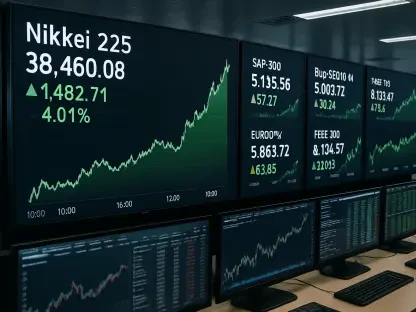The U.S. stock market faces a critical juncture as it navigates a wave of tech earnings reports and looming tariff impositions by the government. Investors and market analysts are keenly observing these developments as stock futures experience slight advances, setting the stage for pertinent high-stakes events. The market’s subtle progress early in the week indicates an environment ripe for shifts, with both economic policies and technological advancements playing influential roles. The spotlight is particularly on the stock futures of major indices like the S&P 500, Nasdaq 100, and Dow Jones Industrial Average, all displaying minor gains in anticipation of forthcoming disclosures.
Stock Futures and Investor Anticipation
Gains in Major Index Futures
Stock futures for the S&P 500, Nasdaq 100, and Dow Jones Industrial Average have taken center stage, reflecting an intricate interplay of economic strategies and corporate performance. Currently, these indices signal marginal growth with futures for the S&P 500 and Nasdaq 100 each climbing approximately 0.3%, while futures for the Dow Jones Industrial Average show an uptick of 0.2%. This nuanced movement suggests a potential continuation of the previous week’s rally, which notably bolstered the Nasdaq Composite and S&P 500, even as the Dow showed a slight decline. Market participants remain vigilant, balancing optimism with caution amid awareness of the unpredictable nature of impending tariffs and tech earnings.
Influence of Market Trends
The mood in the market is significantly molded by strategic anticipation of key trends in tech earnings and macroeconomic indicators. Despite preceding challenges, these slight upward movements in major index futures set a foundation for broader market behavior. Investors are attuned to the developments in fiscal policies, particularly trade tariffs, that might cause disruptions. Simultaneously, tech earnings reports provide substantial influence, especially as data from previous quarters revealed 86% of reporting S&P 500 companies surpassing Wall Street estimates. This context compounds interest in analyzing how companies perform amid shifting economic expectations and heightened scrutiny of their capability to maintain growth trends.
Critical Factors Influencing Market Behavior
Trade Policies and Tariff Implications
Trade policies remain one of the most powerful determinants in the current market framework. The president’s proposed tariffs, scheduled for August 1st, hold the potential to profoundly impact trading conditions. The commerce secretary emphasized this deadline as a pivotal “hard stop,” even as dialogues continue in search of resolutions. With the European Union willing to negotiate an unequal trade arrangement, it suggests an openness to compromise, although there are tangible preparations for countermeasures should diplomacy falter. These actions not only shape international relations but also alter investor expectations, posing potential disruptions and uncertainty in the market should agreements exceed the stated timeframe.
Earnings Season Insights
The unveiling of tech giants’ quarterly earnings, particularly from Alphabet and Tesla, contributes critical insights that may either validate or challenge prevailing market valuations. As members of the “Magnificent Seven” tech firms, their performance and insights into future developments like AI growth are highly anticipated. The emphasis on artificial intelligence recalls echoes of past tech bubbles, inviting speculation about possible overvaluation concerns. This earnings season is marked by a broader awareness of how these tech corporations manage expectations about innovation and change, potentially setting a precedent for how other sectors respond amid economic fluctuations.
Economic and Corporate Developments
Wider Economic Indicators
Beyond the stock futures and tech sector, other economic indicators cast significant influence on the market’s broader narrative. Domino’s Pizza exceeding sales predictions exemplifies adaptability even in uncertain environments, suggesting that innovation in product offerings can mitigate adverse economic effects. Meanwhile, companies like Verizon Communications and Cleveland-Cliffs also present important financial disclosures. Combined, these reports help delineate economic health and overall consumer confidence as investors dissect these outputs for indications of emerging trends and stability. This macroeconomic analysis remains crucial as stakeholders assess the capability of long-term resilience in diverse sectors under challenging policies.
Corporate Sector Adjustments
Economic pressures continue to challenge companies’ adaptation strategies, notably seen in Stellantis’ projection of a $2.7 billion first-half loss this year. The automotive maker’s key challenges stem from restructuring, decreased sales, and tariff implications, with a noticeable 25% decrease in North American shipments year-over-year. This highlights the broader struggles within the automotive industry, confronting the dual pressures of regulatory shifts and competitive landscapes. Companies across sectors must navigate evolving trade policies while seeking operational adjustments that ensure viability, as changing cost structures and market conditions come into play.
Strategic Movements and Geopolitical Concerns
TSMC’s Market Valuation Milestone
Taiwan Semiconductor Manufacturing Co.’s recent milestone of achieving a market valuation exceeding $1 trillion marks a significant leap in the semiconductor industry. This milestone is emblematic of its dominant role as a critical supplier to industry titans like Apple and Nvidia. TSMC’s market surge, driven by investor confidence in its strategic positioning within an AI-driven economy, exemplifies the growing potential within this industry. Amplified recognition from global leaders in technology fosters expectations of further revenue growth, with stakeholders watchful of TSMC’s ability to maintain innovative leadership while expanding capacity to meet demand.
Oil Prices and Geopolitical Influence
The U.S. stock market stands at a pivotal moment, facing a blend of anticipated tech earnings reports alongside impending government tariff implementations. These elements are front and center for investors and market analysts who are closely scrutinizing the situation as stock futures demonstrate slight upswings, underscoring significant events on the horizon. The week’s early modest gains portray a landscape primed for transitions, with economic policies and technological advancements emerging as key influencers. Notably, the stock futures of major indices such as the S&P 500, Nasdaq 100, and Dow Jones Industrial Average are showing minor ascension in readiness for imminent disclosures. This environment is a testament to the dynamic forces at play, with market players actively evaluating how these impending announcements might shape the landscape. All eyes are on the sector leaders, whose reports may bring clarity or further unpredictability to the current climate, influencing decisions in an already fragile period.









